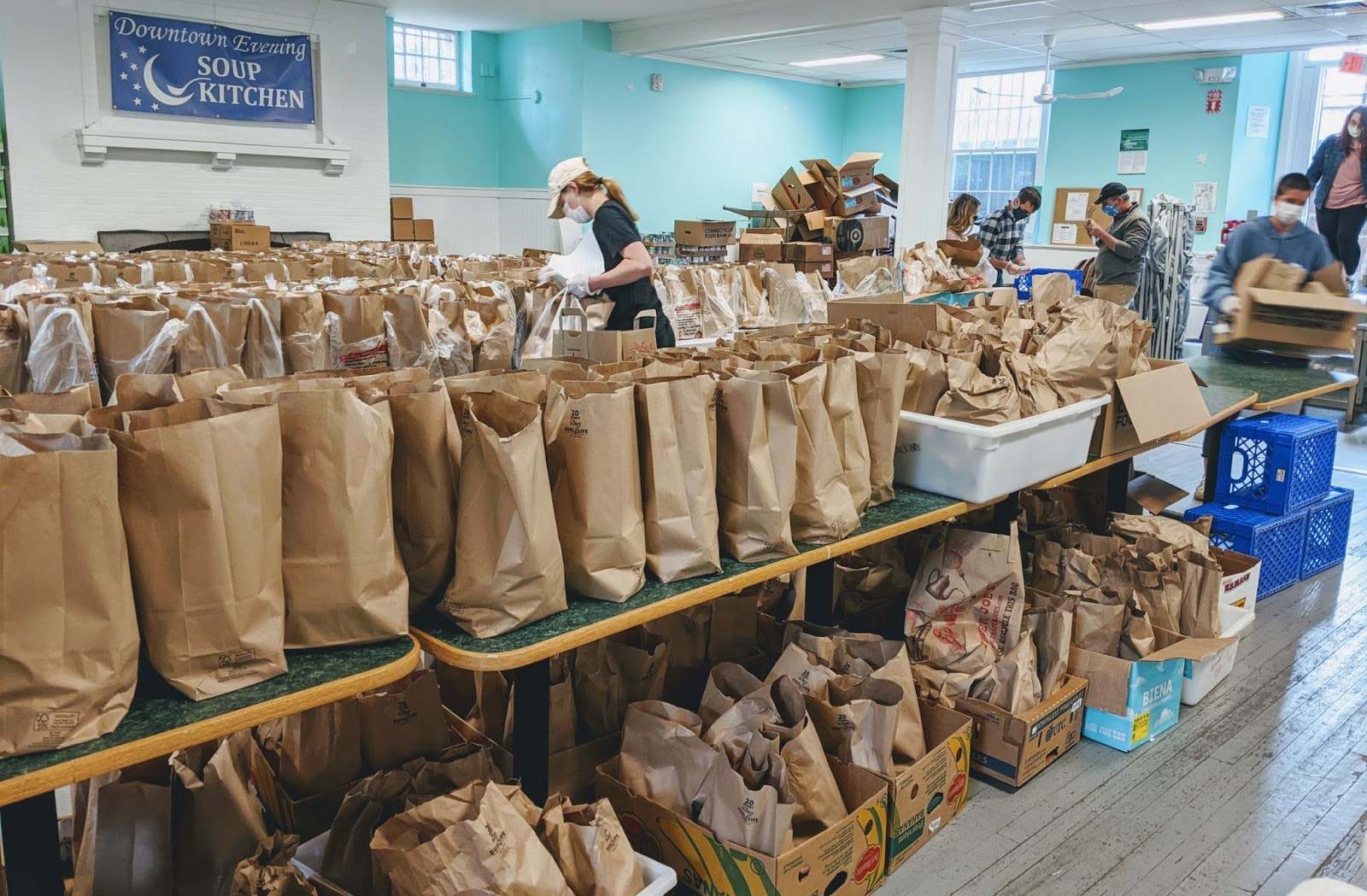‘It changed what we had to do overnight’: How nonprofits and community organizations kept New Haveners fed during a pandemic
Amid the challenges of the pandemic, food banks, soup kitchens, churches and homeless shelters have collaborated and reinvented their service models to address food insecurity in the Elm City.

Courtesy of Steve Werlin
When COVID-19 began to spread in New Haven last spring, many local nonprofits providing hunger relief had to drastically change their service models while combating a new wave of food insecurity.
The widespread financial strain brought on by the pandemic left many New Haveners struggling to provide food for themselves and their families. Amid the increased demand, nonprofits across the Elm City had to mobilize to an unprecedented level, adapting their services to ensure the health and safety of those seeking food assistance. As hunger relief organizations collaborated and amplified their usual services, other groups also made food distribution a central part of their work. Now, as the city begins to reopen, these organizations are considering how pandemic-time innovations will impact the future of their fight against food insecurity.
“This really is a community effort and the community has really come together, so it is uplifting,” said Jason Jakubowski, president and CEO of Connecticut Food Bank. “In terms of strategy, when COVID first happened, it changed the way that we distribute food overnight, literally it changed what we had to do overnight.”
The state of food insecurity in New Haven
When the pandemic hit the Elm City last year, it brought great economic and social upheaval with it. Offices and businesses closed during lockdowns, while many residents lost their jobs. These changes sent greater numbers of residents to food pantries and soup kitchens.
Jakubowski told the News that food is often the first thing that families choose to sacrifice when they are facing financial hardship.
“They’re put in a position in which they want to pay their rent, they want to pay electricity and they want to pay for medication and they want to pay for school … study after study has shown that food is a thing that goes by the wayside,” Jakubowski said. “People say, well, I can’t do without my heating and my electricity, but I could go a couple of days without food.”
Hebe Kudisch, chief program officer for homelessness service provider Columbus House, told the News that widespread unemployment has led to a significant rise in the number of people experiencing food insecurity. She added that many Columbus House clients were “afraid” to go out and get groceries when the pandemic began.
At CitySeed’s farmers’ markets, where benefits from the Supplemental Nutrition Assistance Program, or SNAP, and other federal nutrition programs can be redeemed at twice their value, the proportion of customers using food stamps increased by 50 percent, according to CitySeed Executive Director Cortney Renton. At the same time, there was a significant decrease in visitors to the farmers’ market overall because CitySeed hosted fewer markets due to public health concerns.
Steve Werlin, executive director of Downtown Evening Soup Kitchen, or DESK, told the News that in the past year he has anecdotally noticed a much greater number of residents seeking out their meal services. In particular, he noted that many of these new clients were experiencing homelessness for the first time in their lives, a testament to the “vulnerability” of their financial situations prior to the pandemic.
“It’s required a lot of [food assistance nonprofits] to grow up really fast, and to really start operating at a level that we haven’t had in the past,” said Werlin. “There’s just an awful lot of capacity building that had to take place.”
PPE and grab-and-go meals: Adapting services amid the pandemic
In order for organizations to build their service capacity enough to account for this new wave of food insecurity, nonprofits providing food assistance had to find ways of increasing their funding.
The Community Foundation for Greater New Haven has increased their “basic needs” grantmaking by 80 percent since the pandemic began, according to Senior Vice President for Grantmaking and Strategy Christina Ciociola. Matthew Higbee, content and engagement manager for the Community Foundation, added that 99 of the 220 grants awarded through their joint COVID-19 relief fund with United Way went to projects related to food insecurity.
These grants are intended to help local nonprofits with the difficult task of adapting their usual operations to pandemic safety restrictions and meeting increased demand, according to Ciociola.
According to Jakubowski, CT Food Bank had to change the model of distribution at their food pantries across the state when the pandemic began, shifting to having people pick up pre-packaged boxes of food while inside their cars at temporary drive-through sites.
He noted that this mode of pre-packaged distribution is not the “optimal way of solving and addressing hunger” because it limits client choice. Prior to the pandemic, people could walk around to different tables and choose which food items suited their needs best.
At the Walk of Faith Church, a similar model was used to distribute bags of food that were picked up in advance from local food banks. According to Fay Williams, the pastor’s wife who coordinates these efforts, people at their weekly distribution events are given numbers and told to remain in their cars until called. These individuals then go around one at a time, maintaining physical distancing, to collect their food.
Jakubowski said that he gives “all the credit” to organizations that prepare food on site, observing that their transition to a COVID-safe form of distribution would have been much more difficult.
At DESK, the pre-pandemic buffet service in an indoor communal dining room was abandoned in favor of a grab-and-go style of meal distribution. According to Werlin, they have not served food inside since March 12 of last year — but outdoor tents and tables at their Temple Street location has allowed them to keep operating throughout the entire course of the pandemic.
Social distancing and mask wearing are enforced, and guests have their temperatures taken upon arrival. Staff are tested every other week, according to Werlin. Most staff and clients are also now fully vaccinated.
Citywide collaboration and coordination
In early 2019, a group of local nonprofits focused on combating food insecurity came together under the leadership of CARE — an organization co-run by the Yale School of Public Health and Southern Connecticut State University. This new collective called itself the Coordinated Food Assistance Network, or CFAN.
Though the groups involved with CFAN met semi-regularly prior to the pandemic, participation “blew up” in March of last year, according to Werlin. He said the CFAN meetings, which took place every single day over Zoom at the start of the pandemic, had the atmosphere of a “situation room.” Between 20 and 40 leaders of New Haven food assistance nonprofits and homelessness service providers gathered to discuss how to respond to the unprecedented new crisis.
“CFAN was really strengthened through COVID,” Renton said. “The food pantries, soup kitchens, the direct frontline food access organizations, they’re part of that collaborative. We’re able to really coordinate resources and make sure that the most vulnerable people are getting what they need.”
CFAN began its biggest project when DESK and food assistance nonprofit Loaves and Fishes began coordinating a delivery system to bring food directly from pantries to the homes of New Haveners in need, using a grant from Yale. This program, called “Pantry-to-Pantry,” targeted immunocompromised residents who were homebound and food insecure.
Then, in September 2020, the leadership of Pantry-to-Pantry shifted to Food in Service to the Homebound, or FISH, a nonprofit with years of prior experience in food delivery programs.
According to Executive Director Jill Meyerhoff, FISH is one of the few New Haven pantries that delivered food prior to the pandemic, bringing groceries to homebound elderly or disabled residents. Due to this, they had the basic infrastructure to run CFAN’s delivery program, but had to quickly build capacity to handle the new demand.
“It wasn’t sustainable for [other nonprofits], but it was sustainable for us,” Meyerhoff said. “So we increased our amount of deliveries that we were doing. We increased our capacity, we had to move to a larger warehouse with the needed industrial shelving to accommodate. So we’ve expanded during this year.”
Another crucial element of the citywide collaborative efforts that took place to combat pandemic-time food insecurity was the participation of smaller nonprofits and nonprofits not traditionally involved with food distribution.
Ciociola told the News that small community garages and church groups were “instrumental” in getting food to the people who needed it during the pandemic, listing Williams’ work at the Walk of Faith Church as an example.
Last summer, the New Haven Pride Center launched a 17-week food distribution program targeting LGBTQ+ community members. According to Executive Director Patrick Dunn, they handed out a total of about 65,000 pounds of food during this period, packed in boxes of 50 to 60 pounds each.
After funding for this program ran out, the Pride Center shifted in August to a stationary pantry model, giving out purchased and donated nonperishable food items to clients who sought out assistance. Dunn added that they also have a “stockpile” of grocery store gift cards that they distribute upon request.

Reimagining the fight against food insecurity
Many of the nonprofit leaders that the News spoke with emphasized a recent feeling of “light at the end of the tunnel,” with vaccinations and reopenings creating a mood of optimism. Kudisch told the News that she has noticed a higher rate of reemployment for Columbus House’s clients, a trend that she believes is key to getting people out of situations of homelessness and food insecurity.
However, a return to complete normalcy appears to be far off for food assistance nonprofits — in fact, many directors like Werlin hope that pandemic-time upheavals will contribute to a “reimagining” of what hunger relief can look like.
He told the News that the pandemic has allowed nonprofits of all types to “throw out the playbook” and innovate, pointing to the new hotel model for homeless shelters. Werlin hopes that DESK will continue to serve food outside, commenting on how it limits the time spent waiting in lines. In addition, he listed CFAN as an example of a promising new ethos of collaboration within the nonprofit sector.
“Now that COVID is over, there are so many more people that are in need of food,” Meyerhoff said. “[We have to] come together and be able to work more simultaneously to help each other out, to make sure that we’re accessing all of the food necessary to be able to feed everybody that is in need now.”
After COVID, nonprofit leaders said long-term policy changes and community outreach are also central to combating food insecurity in New Haven.
Renton spoke to the News about CitySeed’s business and career development programs, which are designed to uplift food entrepreneurs and chefs from marginalized communities. These programs, Renton said, are also a “food access and food insecurity strategy” — they work to keep the participants out of poverty, while also encouraging the growth of food businesses in underserved communities across New Haven.
Organizations like CT Food Bank and Witnesses to Hunger are also involved with advocacy for permanent legislative action to address food insecurity. According to Jakubowski, CT Food Bank has spent much of the pandemic reaching out to state and federal policymakers and encouraging them to invest in SNAP benefits.
Witnesses to Hunger is a national advocacy group composed of people who have experienced food insecurity themselves. According to Kimberly Hart, site leader for the New Haven chapter, their organization is currently fighting for year-round free meals for children in need, a move that was motivated by the impact of school closures.
“A pandemic is not going to last forever, because nothing lasts forever,” Hart said. “We’re not going back to normal as we knew it, but we’re going to a new normal. And in this new normal, we’d like to say that children should be fed.”
As of 2020, 16.2 percent of New Haven’s population is estimated to be food insecure, according to Connecticut’s Office of Legislative Research. In 2018, this figure was 12.1 percent.
Clarification, May 6: This story has been updated to more accurately portray why total attendance at CitySeed farmers’ markets fell last year.









